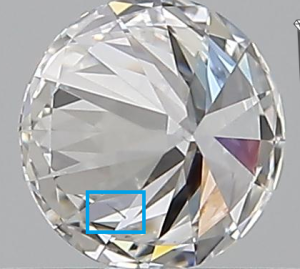Diamonds, the luminary icons of strength and love, carry a universe within them. Each diamond’s interior echoes stories of an arduous journey traversed over millions of years. One of the fascinating chapters of this tale involves ‘Needle,’ a distinctive diamond inclusion.

Understanding the Genesis of ‘Needle’
A needle, in the context of gemology, is a thin, elongated inclusion within a diamond. It resembles its namesake – a sewing needle, maintaining a delicate, thread-like appearance. This characteristic inclusion isn’t a foreign entity but an integral part of the diamond, composed of the same elemental carbon.
These inclusions form deep within the Earth’s crust under extreme pressure and temperature, intrinsic to diamond genesis. It’s during this growth phase that certain diamonds may encapsulate tiny carbon remnants, which under enduring heat and pressure, grow into needle-like structures.
Needle Inclusions and Diamond Clarity
Diamond clarity refers to the absence of inclusions and blemishes. When needles occur singularly and are small or located prudently, they may have a negligible impact on a diamond’s clarity grade. However, when they appear in clusters or are prominently sized, they can affect the gem’s overall clarity.
The position of these needle inclusions also matters significantly. Inclusions closer to the diamond’s table (the flat top surface) are typically more visible and can notably affect the clarity grade. In contrast, those located towards the girdle (the widest perimeter) or pavilion (lower portion) might not be as visible.
The Influence of Needle Inclusions on Diamond Value
The value of a diamond hinges upon the “Four Cs” – Cut, Clarity, Color, and Carat. The clarity, specifically, is influenced by the size, number, position, and nature of inclusions like needles.
Small needles may often remain unseen by the unaided eye and do not substantially affect the diamond’s value. Conversely, larger needles or a cluster of them can depreciate a gem’s worth. For some, however, these distinctive inclusions offer a touch of personality, a whisper of the diamond’s fiery birth and protracted voyage.
Needle Inclusions: Potential Impact on Light Performance
When it comes to the effect on a diamond’s brilliance and fire, needle inclusions play a rather nuanced role. An isolated, minute needle is unlikely to disrupt light travel within a diamond significantly. However, an array of these, especially near the table, could somewhat scatter incoming light, thereby influencing the gem’s sparkle.
Again, the extent of impact largely relies on the needle’s size, position, and orientation within the diamond. Expert cutters can often work around these inclusions, optimizing the diamond’s facets for maximum light performance.
The Artistic Perspective: Needle Inclusions as Unique Identifiers
Every diamond is unique, a canvas where nature has left its abstract strokes in the form of inclusions. For those who appreciate the natural aspect of diamonds, needle inclusions might not be a flaw but a distinct fingerprint, imbuing individuality to each gem.
For such individuals, needle inclusions can transform a generic symbol of luxury into a personal emblem of love, strength, and enduring beauty, encapsulating the grandeur and mystery of nature’s artistry.
The Enigmatic Charm of Needle Inclusions
The world within a diamond is a realm filled with untold narratives. Needle inclusions, though often regarded as imperfections, are an inherent part of these stories. They echo the tumultuous conditions under which diamonds form, making each diamond a unique time capsule. Whether a needle inclusion adds a distinct charm or detracts from a gem’s value relies heavily on one’s perspective and knowledge. Armed with an understanding of these unique inclusions, one can better appreciate the intricate tapestry that is a diamond’s inner world.